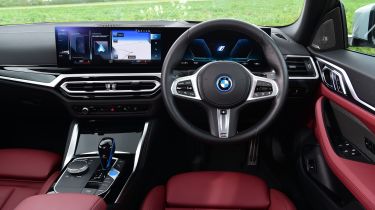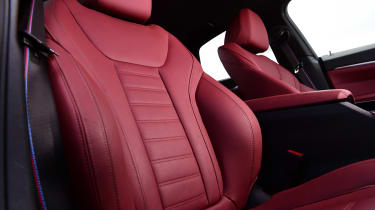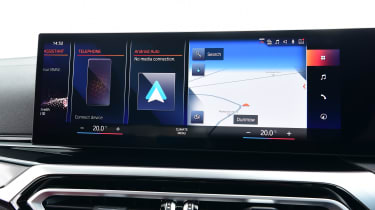BMW i4 review: interior, dashboard & infotainment
Interior quality and layout are both excellent, and BMW's infotainment system is incredibly responsive - if a little confusing at times
Near-flawless build quality and logical, driver-focused layouts have been a hallmark of BMWs for many years and the i4 doesn’t deviate from that template. If you’re looking for something that can function as a sports car as well as a family car, the i4’s low-slung driving position means it can fulfil both criteria.
BMW i4 dashboard
The layout of the i4’s cabin will be very familiar to any current 3 or 4 Series owner. Build quality is excellent, and the overall design is clean and minimalistic, with eyes no-doubt being drawn to the large curved display panel mounted atop the dashboard. This comprises a 12.3-inch instrument cluster and a 14.9-inch infotainment touchscreen – it's the same setup you'll find in BMW's flagship iX SUV and is now starting to make its way into the brand's other models.
The high centre console helps to cocoon the driver, providing a cockpit-esque feel and housing several of the car’s controls. Tucked away out of sight and accessed via a very expensive-feeling sliding lid is a standard-fit wireless smartphone charger. We like how there’s still several physical shortcut buttons for the different drive modes and radio presets, but we wish the climate settings weren’t integrated into the touchscreen – at least they remain in a permanent position at the bottom of the display.
Equipment, options & accessories
The i4’s trim-level hierarchy is fairly straightforward. The eDrive35 and eDrive40 rear-wheel drive models are offered in Sport and M Sport specifications, while the more powerful, range-topping M50 serves as its own trim level.
Standard equipment on the Sport includes 18-inch alloy wheels, a powered tailgate, blue exterior design highlights, ambient lighting, automatic air-conditioning, Alcantara suede upholstery, heated front seats, split-folding rear seats, a leather sports steering wheel, automatic wipers and headlights, cruise control, LED lights all round, parking assistance, a reversing camera, the 14-inch infotainment screen and 12-inch driver’s display.
M Sport has a different design of 18-inch alloy, plus M Sport-specific front bumper among other styling changes. Aluminium interior trim and an M Sport steering-wheel design also feature inside. Adaptive suspension also means the M Sport car should be slightly more capable in terms of both comfort and handling as the base Sport.
Comfort, Comfort Plus, Visibility, Technology and Technology Plus packs are also available for both Sport and M Sport models, while individual options offered include an electric sunroof, towbar and Harmon Kardon sound system.
The M50 gets 19-inch alloys as standard, along with similar external styling enhancements to the M Sport. Powered memory seats trimmed in full leather, along with the aforementioned adaptive suspension and more-powerful M Sport brakes, are standard here, too. Visibility, Comfort, Technology Plus and M Technology Packs can be added at an extra cost.
Infotainment, apps & sat nav
The infotainment system doesn’t disappoint, with vivid and crisp graphics, plus a responsive user interface. You can tap the central touchscreen to navigate through menus and functions, but the i4 also features the familiar iDrive rotary dial; although, whichever method you use, it can be difficult to navigate the array of icons and sub-menus on the screen while driving.
If you prefer to just use Apple CarPlay or Android Auto, apps are fully integrated into the main touchscreen, and they both look and function brilliantly as a result. As for BMW’s software, the driver can configure the home screen via widgets and the dials to display things like the sat nav maps or efficiency data – we wish these were a bit brighter and even more configurable, though.






